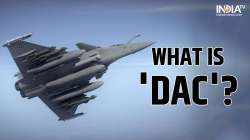Rafale deal: What is Defence Acquisition Council? Know about India's weapons procurement policy
Defence Acquisition Council hit the headlines on Thursday after giving approval to three major defence deals with France that includes the procurement of 26 Rafale Marine aircraft.

Rafale deal: In a significant move which will boost India's defence amid multi-layered challenges to the nation's security in the wake of a rapidly changing geopolitical equation, the Defence Acquisition Council (DAC) on Thursday approved plans to buy 26 Rafale fighter aircraft and three Scorpene class conventional submarines for the Indian Navy from France. The development comes amid PM Modi's France visit.
The DAC held a meeting under the chairmanship of Defence Minister Rajnath Singh in which it gave the green signal to three proposals-
- 1. Acceptance of Necessity (AoN) for procurement of 26 Rafale Marine aircraft along with associated ancillary equipment, weapons, simulator, spares, documentation, crew training and logistic support for the Indian Navy from the French Government based on Inter-Governmental Agreement (IGA).
- 2. The AoN for procurement of three additional Scorpene submarines under 'Buy' (Indian) category which will be constructed by Mazagon Dock Shipbuilders Limited (MDL).
- 3. Approval to lay down guidelines for achieving the desired indigenous content in all categories of capital acquisition cases. It will help in achieving ‘Aatmanirbharta’ in critical manufacturing technologies and life-cycle sustenance of defence platforms/equipment through indigenous manufacturing.
As DAC is in the news for clearing crucial defence deals with Franch which will have a far-reaching impact on boosting India's defence. Let's examine what is DAC and why its role is important in defence procurements.
What is DAC?
The DAC is the highest decision-making body of the Defence Ministry on procurement. It was formed after the Group of Minister (GoM)'s recommendations as a part of 'reforming the National Security System', in 2001 post-Kargil War (1999). The chairman of the council is the Defence Minister, hence, present Defence Minister Rajnath Singh is the head of the DAC. Other members of the DAC are- the Chief of Defence Staff (CDS) and chiefs of the Army, Navy, and Air Force.
What was the objective to form DAC?
Post-Kargil war several loopholes reportedly surfaced in the procurement of defence equipment and arms. The government decided to carry out reforms in the defence sector. As a part of the reform in defence, the DAC was formed to ensure expeditious procurement of the approved requirements of the armed forces. The Defence Acquisition Council was given the rights to give in-principle approval of a 15 years 'Long Term Integrated Perspective Plan' (LTIPP) for defence forces.
How it functions
DAC makes an accord of acceptance of the necessity of acquisition proposals. It also actively participates in categorisation of the acquisition proposals relating to ‘Buy’, ‘Buy & Make’, and ‘Make’. It entertains the subjects related to single vendor clearance. The council takes decisions on ‘offset’ provisions in respect of acquisition proposals above Rs 300 crore. DAC takes decisions regarding the Transfer of Technology under the ‘Buy & Make’ category of acquisition proposals. It makes 'Field Trial Evaluation' (FTE).
The procedure of defence procurement
DAC’s AoN (Acceptance of Necessity) is the first step towards procuring military equipment/hardware/arms/jets. The DAC’s clearance under the defence procurement policy is the most important category of defence acquisition. After AoN, the concerned procure department of proceed with the deal under DPP 2016.
New Defence Procurement Procedure (DPP- 2016)
According to a statement released by the Defence Minister on February 05, 2018, the new Defence Procurement Procedure (DPP) - 2016 has been implemented by the Government with effect from April 1, 2016. DPP-2016, inter alia, focuses on institutionalizing, streamlining, and simplifying the procedure to give a boost to the ‘Make in India’ initiative of the Government of India, through Indigenous design, development and manufacturing of defence equipment, platforms & systems. The ‘Make’ procedure has been simplified to ensure increased participation of the Indian industry. In order to promote indigenous design and development of defence equipment, DPP-2016 has introduced a new category for capital procurement viz. ‘Buy (Indian-IDDM)’ (Indigenously Designed Developed and Manufactured). While categorising a case, this category is accorded the highest priority by the Buyer.